 |
A.P.J. ABDUL KALAM
HON. PRESIDENT OF INDIA, Scientist, educationist, musician |
The Boffin
At The Bhawan
India's President, a scientist himself, is reflection
of the nation's aspirations.
Infosys' sprawling
bangalore campus, ranbaxy's research facility in Gurgaon, and Rashtrapati
Bhawan have come to figure in the itinerary of most heads of state
and heads of business who visit India. The present occupant of the
Bhawan is the son of a fisherman who rose to be one of the country's
most-respected scientists. If a nation is known by its first citizen,
then India is, at once, a meritocracy, a hotbed of scientific talent,
and a developed nation in spirit.
Since July 25, 2002, when he took up office,
Kalam has delivered 230 speeches on subjects as varied as fashion
technology, the challenge of development, even the use of nano-technology
in brain surgery. The typical speech ends with a series of questions,
a sort of try-this-for-size challenge the President tosses out to
all takers. Posing questions comes naturally to Kalam the scientist.
Once, when he was head of India's Defence Research Development Organisation,
he visited a friend who had undergone an angioplasty. He got talking
to the surgeon in charge, Dr Som Raju, about stents, metal spirals
inserted into the blood vessel. Angioplasties were expensive, explained
Raju, because the stents cost Rs 75,000. Kalam got a local defence
research lab to collaborate with Raju; the result was the indigenous
Kalam-Raju stent, made with the same anti-corrosion technology used
in submarines and costing around Rs 5,000.
This background gives the President's call
to arms credibility: management guru C.K. Prahalad heard Kalam's
call to make India a developed country by 2020 for the first time
at a conference in Cochin. His reaction: Nothing like this had happened
to India since Mahatma Gandhi's call for Poorna Swaraj. That's because,
nothing like A.P.J. Abdul Kalam has, either.
-Vidya Viswanathan
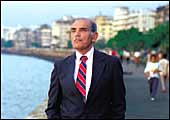 |
F.C. KOHLI
FORMER DEPUTY CHAIRMAN, TCS, Technocrat, manager, visionary |
The Father Of Coders
The founder of TCS engendered India's most global
industry, software.
If you are an Indian,
goes prevailing logic, you must be a good software engineer. The
image of Indian coders going at it in Silicon Valley, the heart
of the world's technology industry, has become so ubiquitous that
mainstream American media is no longer excited by once-novel disclosures
about a canteen at Oracle serving sambhar. Attribute that to one
man: Fakir Chand Kohli. In the early 1960s, Kohli, now 77, was a
director on the board of Tata Electrical Company, one of the six
utilities in the world to be digitised; in the late 1960s, when
the Tata Group decided that Tata Consultancy Services (TCS) would
focus on technology solutions, he was a natural choice to head it.
Kohli was convinced India could exploit the global market for software
and for warm bodies familiar with code. The discipline of software
engineering wasn't around in those days, so TCS decided to recruit
engineers and masters in science in any discipline and train them.
By 2000, an estimated 20,000 TCS-trained engineers were working
for other companies. Body-shopping gradually gave way to offshoring
but as early as 1974 TCS developed a healthcare system for Burroughs
out of India. And the body-shopping boom had its positives: how
else would the world have learned about Indian it?
-Vidya Viswanathan
 |
N.R. NARAYANA MURTHY
CHAIRMAN, INFOSYS TECHNOLOGIES, Entrepreneur, global manager,
mentor |
The Compleat Manager
Infosys' Chairman made Indian software, even
industry, respectable.
If the world cannot
seem to have enough of Nagavara Ramarao Narayana Murthy, it's because
he was the very antithesis of the typical (and stereotypical) Indian
entrepreneur: austere, willing to share wealth with employees, governance-oriented,
and focused on building a global brand and corporation. The result
is a company that has, to its credit, a seemingly unending list
of firsts: Infosys was the first Indian company to issue stock options,
host analyst meets, list on NASDAQ-essentially, the first Indian
company to grab Western eyeballs. Murthy lavished money and attention
on the company's Bangalore campus; he wanted overseas visitors to
take back the message that Infosys was no sweat-shop. And he splurged
and hosted customer meets at the best hotels in the US: one year,
the setting was New York's famed Waldorf Astoria. Infosys was the
immediate beneficiary, but then, the rest of the Indian it industry
and, eventually, all of India Inc gained from Murthy's efforts.
Not surprisingly, rumours abound about his appointment to public
office. The man belongs there.
-Vidya Viswanathan
The Networked Nation
The network and cluster effects make it difficult
for the world to ignore India.
 |
ITPL
WHITEFIELD, BANGALORE
102 tech companies, over 50% MNCs |
Ideas, and ideators,
do not thrive in vacuum. The latter, whether it is individuals or
organisations, do well in clusters, such as the software one in
Bangalore or pharmaceutical one in Hyderabad.
Most ideas that see the light of day are the
result of fertile networks incorporating inventors, companies, venture
capitalists, and markets. India has always been a network-oriented
culture-"I know someone who knows someone ..."-and it
was but a matter of time before someone extended the Rolodex-pumping
concept to ideas. Take, for instance, the network of TeNet Group,
an incubator founded by Ashok Jhunjhunwala a professor at IIT, Madras.
Today, TeNet works with hp, is designing an ultra low-cost automated
teller machine for ICICI Bank, and has venture capitalists lining
up to fund the companies it starts up. There are more such examples:
R. Chidambaram, Principal Scientific Advisor, Government of India
has put together a project called Core Group on Automotive R&D
that will develop advanced technologies for the automotive industry;
participants include several government labs and Indian automotive
companies; now, Chidambaram wants to sell the concept to non resident
Indians in the auto trade. The network, as Chidambaram knows, is
everything.
-Vidya Viswanathan
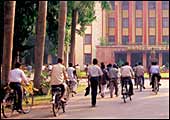 |
IIT
KHARAGPUR
Vinod Gupta studied here |
India's Best-known School
The US has MIT and Caltech; India, the Indian
Institute of Technology.
Whether it is the
pioneering algorithms of Narendra Karmarkar, the innovative leadership
of Manohar Parrikar, or the countless start-ups in Silicon Valley,
they all have their genesis in the innovative brain of an IITian."
That's Infosys ceo Nandan Nilekani's tribute to his alma mater (he
is from IIT, Bombay). Even before Dilbert creator Scott Adams immortalised
the schools-there are now seven of them and if the Government of
India has its way, the number could go up to 20-in his strip (the
super-intelligent techie Asok is from IIT), the schools were well
known in the West. The majority of each graduating batch from the
IITs heads West. The achievements of those who have trod this path
has directed the world's attention to the IITs. Not content with
merely serving as a finishing school for some of the world's best
science talent, the IITs have now embarked on collaborative research
initiatives with companies-IBM's India Research Center, for instance,
has a partnership with IIT, Delhi-and, to use the words of R.K.
Misra, Director, IIT, Bombay, "are harnessing ideas for the
benefit of the country."
-Kushan Mitra
Socialist Baggage
Time was, when the state had to do everything.
Thank God.
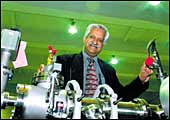 |
PROF. V.S. RAMAMURTHY
SECRETARY, DST
Bureucrat and scientist |
One man who deserves
much of the credit for modern India's scientific and technological
prowess-he rarely gets any for it-is the country's first Prime Minister,
Jawaharlal Nehru. Self-reliance in science, after all, was one of
the main strands of the Nehruvian school of socialism. Even before
the country became independent, Nehru invited renowned scientist
Shanti Swarup to build the scientific infrastructure of independent
India. Swarup, who was the founder of the Council of Scientific
and Industrial Research (it was set up in 1942) recommended that
the country invest in state-owned national laboratories. In April
1947, four months before India became independent, the National
Chemical Laboratory in Pune came into existence. The government
established a clutch of others-National Physical Laboratory, Delhi;
Central Fuel Research Institute, Dhanbad, and Central Food Technological
Research Institute, Mysore included-in 1950. Then, there were entire
government departments that Nehru created: among the first, were
the departments of science and technology, space, and atomic energy,
and he personally oversaw the three. Today, India boasts over 200
national laboratories. That's one reason why India, circa 2004,
has world-class capabilities in emerging areas such as molecular
biophysics, liquid crystal displays, superconductivity, advanced
materials, and atmospheric sciences. Why, it is one of the nine
nations that have successfully launched satellites. Much of this
technology is now being patented: with 184 patent applications,
CSIR was the single largest patent filer under the World Trade Organisation's
Patent Cooperation Treaty (it shares the top spot with South Korea's
Samsung) in 2002. Better still, India's government labs are increasingly
looking to commercialise their IP (Intellectual Property). Textbook
socialists may not approve of this development, but the country
has come a long way since the 1940s.
-Sahad P.V.
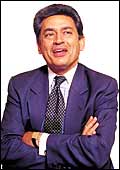 |
RAJAT GUPTA
FORMER MANAGING PARTNER, MCKINSEY & CO
The most-visible of them all |
Mindspace From Corner Rooms
Having several Global Indian Chief Executive
Officers Helps
It was an eventuality
waiting to happen and, finally, in the mid-1990s, it did. Graduates
of the Indian Institute of Technology started looking westward in
the mid-1970s. Almost two decades later, the US woke up to Indian
CEOs. There was Rajat Gupta at McKinsey & Company, the most
visible of them all. There were Rakesh Gangwal at US Airways and
Rono Dutta at United Airlines. There was Shailesh Mehta at Providian
Financial. And there was a clutch of technology entrepreneurs, CEOs,
and venture capitalists. The world already knew Indians to be fine
scientific minds and sincere workers; the assault of the GICEO helped
establish their credentials as great managers. The wave has continued:
circa 2004, an Indian being named to the top post in a multinational
corporation no longer makes news (except for breathless financial
papers). Has this changed the way India is perceived? Suffice it
to say that managers look at a country entirely differently when
they suspect their next CEO could come from it.
-Moinak Mitra
A Billion Reasons Why
A market of a billion keeps companies on their
toes.
 |
METROPOLITAN MALL
GURGAON
Third World Or First? |
Most multinationals,
like GE, came to India to tap its booming (or so they thought) market.
The market disappointed them, but they realised that they could
leverage the country's resources-talented coders and engineers,
say, or plentiful English-speaking call centre agents-to make their
global operations more efficient. And so, they stayed back. Circa
2004, however, most multinationals catering to the Indian retail
consumer will have to admit that the market is beginning to look
attractive again. Attribute that to rising discretionary incomes,
an increase in the number of double-income households, and a first-world-like
attitude to credit. The market is also wholly Indian; products and
communication that worked well elsewhere don't exactly do well here;
and companies have to come up with innovations related to cost and
usage if they wish to succeed in India. And where better to create
ideas for India (or other similar nations) than India?
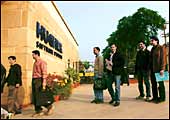 |
HUGHES SOFTWARE SYSTEMS
GURGAON
People-shortage? What's that? |
Supply-side Dynamics
India has a treasure-trove of techies of all
hues.
First, the numbers:
India has 270 universities, 10,000 arts and science colleges, and
2,400 engineering and medical schools that produce 2 million graduates
every year. As of April 2002 some 8.8 million Indians were enrolled
in graduate programmes. IT education in India costs a eighth what
it does in the US. Finally, private spending on education in India
has grown at a CAGR of 10.38 per cent over the past decade. When
people speak about plentiful low-cost English-speaking skilled labour
being available in India, chances are they are referring to one
of the numbers listed above. These supply-side dynamics alone make
it difficult for knowledge-oriented industries anywhere in the world
to ignore India. Then, there's the government's prescience in identifying
the next big thing. As early as the mid-1980s, the National Biotechnology
Board introduced an integrated training programme in biotech. And
the industry really took wing in the 2000s. Any guesses on where
biotech's biggies will find their workforce?
-Sahad P.V.
|
|
|
VERTU
NOKIA'S HIGH-END PHONE
Class, not mass
|
Western R&D
Cost is all.
Replacement and
upgradation, not penetration, are key market drivers in the First
World. Ergo, companies focus their efforts on feature enrichment
rather than cost reduction. A growing number of Indian innovators
and companies have realised this and are in the process of developing
(or have already developed) products and solutions that are relevant
to the Indian market in terms of cost and reach. Think of it as
an Indian model of R&D.
 |
A GROCER'S
THE HEART OF INDIA
A nation of shopkeepers? |
The Second-most Entrepreneurial
Nation
It's simple really. Entrepreneurship equals
ideas.
The long-suffering
British have a joke about Indians. Why don't Indians do well in
football, it goes. The punchline: Well, you show them a corner and
they put down a shop. Most humour is a reflection of reality and
this joke is probably fallout of the growing number of Indian shopkeepers
in England, particularly London. However, Indians in India, the
consensus went, weren't cut out to be entrepreneurs. Sociologist
Max Weber blamed India's caste system for this, arguing that it
restricted each caste to its traditional occupation. Inspired by
Weber, social psychologist David McClelland said Indians had religious
values that didn't promote achievement motivation, the desire to
achieve for its own sake. Weber also offered a corollary that stated
that Jains and Parsis made good businessmen because they has certain
religious values that were the equivalent of the protestant work
ethic. That things have changed since the days of Messrs Weber and
McClelland is evident in the Global Entrepreneurship Monitor (GEM)
a report published in late 2002 by London Business School. This
reckons that nearly 18 per cent of India's workforce is engaged
in some form of entrepreneurial activity as compared to 2 per cent
in Japan and 10.2 per cent in the US (the global average is 7 per
cent). Only Thailand ranks higher. Such entrepreneurial activity
is most evident in new industries. Infosys was promoted by N.R.
Narayana Murthy (he would have been a priest by Weber's calculations)
and five others; Dr Reddy's Laboratories and Apollo Hospitals were
both promoted by professionals (doctors, actually); and one of India's
largest mobile telephony companies was founded by Sunil Mittal,
who started off with a bicycle spare parts business in Ludhiana.
Better still, armed with defection capital, a growing number of
executives are opting for the risky life of an entrepreneur over
their 'safe jobs'. Low achievement motivation, indeed.
-Sahad P.V.
 |
OFF TO SCHOOL
DELHI
Education is everything |
Middle-Class Values
Education and effort lie at the core.
The Indian middle-class believes in the power
of education to make a difference. When it began, for instance,
the great Indian software revolution was largely built around middle-class
engineering graduates from Tamil Nadu and Andhra Pradesh. Today,
the most significant expenditure of middle class households, apart
from rent and food, is education. And while the Indian middle-class
is waking up to the worship of Mammon, intellectual pursuits retain
their lure. Given the choice, most parents would prefer that their
child graduate from IIT rather than play cricket for the country.
|
